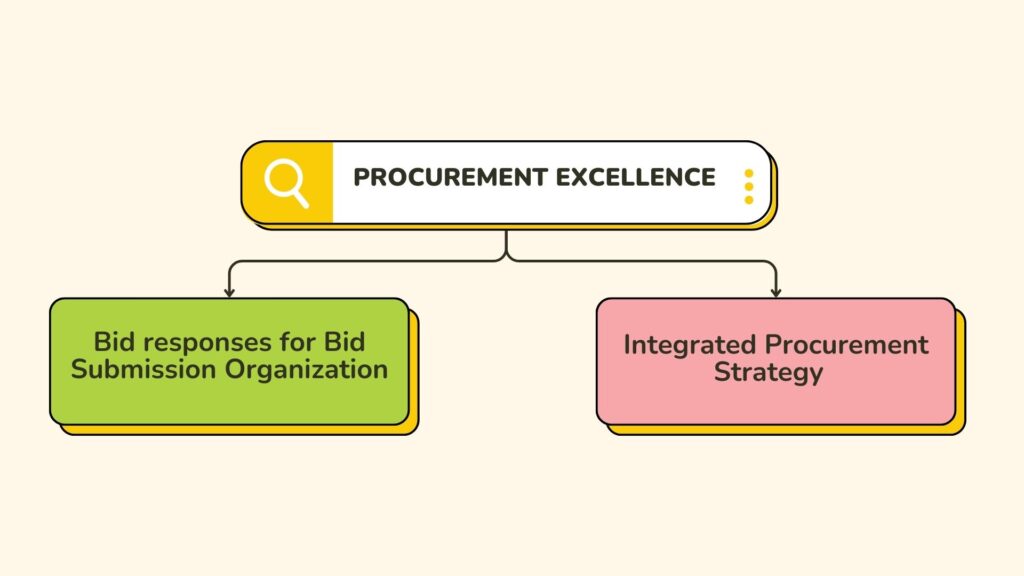Procurement Excellence
- Home
- Procurement Excellence

EXCELLENCE WITHOUT SACRIFICING COST AND QUALITY
Procurement Excellence
Achieving excellence in procurement is vital to remaining competitive and profitable over the long term. SSTC offers a variety of solutions that can help reduce costs, streamline the procurement process, and create a competitive advantage.

6.1 Bid responses for Bid Submission Organization
Overview
Our Approach
Step 1
Lead and manage the bid team, aligning the team’s objectives and responsibilities for maximum efficiency and outcome. Develop a Bid Plan that organizes necessary resources, schedules key meetings, allocates tasks, and ensures deadlines are met.
Step 2
Facilitate information gathering from internal subject matter experts and external sources. This ensures that all relevant data is captured and incorporated into the bid response, aligning with the requirements of the client or tender.
Step 3
Develop high-quality content for all tender responses, including executive summaries, case studies, technical manuals, and operational management plans. Ensure that the solution is clearly communicated, maintaining a balance between sales appeal and technical accuracy
Step 4
Create working templates and tools to streamline the internal bid process, improving efficiency and ensuring governance throughout the lifecycle. These tools may include Bid Management Plans, Go/No-Go Forms, Review Templates, and Compliance Matrices.
Step 5
Prepare a comprehensive Tender Kit for procurement teams. This includes all necessary documents such as Invitation to Tender, Agreement Forms, Conditions of Agreement, Bills of Quantities, and other attachments.
Impact to Clients
➺ Improved Efficiency: Streamline bid processes with well-defined templates and tools, enabling faster responses and reducing administrative overhead.
➺ High-Quality Submissions: Deliver tailored, high-quality bids that align with client needs, increasing the chances of winning contracts and business opportunities.
➺ Governance and Compliance: Ensure regulatory compliance and governance throughout the bid process with clear documentation and review mechanisms.
➺ Strategic Bid Planning: Align each bid with your business strategy, focusing resources on the most promising opportunities.
➺ Clear Communication: Craft compelling and technically accurate submissions that highlight your value proposition effectively.
6.2 Integrated Procurement Strategy
Overview
Our Approach
Deliver Best Value and Savings
➺ Step 1: Assess Procurement Processes – Identify areas where circular and sustainable solutions can reduce costs and improve resource efficiency.
Tools Used: Lifecycle cost analysis, total cost of ownership models, circular economy models.
➺ Step 2: Implement Circular Procurement Practices – Focus on reducing waste, reusing materials, and optimizing product lifecycle management.
Tools Used: Circularity assessment tools, eco-design guidelines, resource efficiency tools.
Embed Sustainable Procurement Practices
➺ Step 3: Establish Sustainable Procurement Policies – Prioritize environmental, social, and economic impacts in procurement decisions. Align strategies with sustainability goals, including ethical sourcing and sustainable product lifecycle management.
Tools Used: ISO 20400:2017 (Sustainable Procurement Guidance), green procurement tools, supply chain sustainability frameworks.
➺ Step 4: Collaborate with Suppliers – Ensure sustainable and circular procurement practices are implemented across the value chain, promoting transparency and ethical sourcing.
Tools Used: Supplier engagement platforms, ethical procurement frameworks, sustainability reporting tools.
Foster Innovation Procurement
➺ Step 5: Drive Innovation Procurement – Identify and procure cutting-edge technologies and services that align with sustainability goals and the circular economy. Encourage the development of new products that minimize environmental impacts.
Tools Used: Innovation workshops, eco-design frameworks, product innovation tools, R&D collaboration platforms.
➺ Step 6: Adopt AI Technologies in Procurement – Optimize supply chain management, demand forecasting, and predictive analytics through AI-driven solutions.
Tools Used: AI-driven supply chain management systems, predictive analytics tools, machine learning algorithms.
Strengthen Information Security
➺ Step 7: Implement Robust Information Security Policies – Protect sensitive data within procurement and sustainability processes by ensuring secure storage and management of procurement data, especially related to suppliers and contracts.
Tools Used: ISO 27001:2013 (Information Security Management System), data encryption tools, access control systems.
➺ Step 8: Integrate AI for Enhanced Data Security – Utilize intelligent monitoring systems, anomaly detection, and real-time threat analysis to safeguard procurement-related data.
Tools Used: AI-based cybersecurity tools, threat detection software, data breach prevention systems.
Seek Collaboration with External Bodies
➺ Step 9: Foster Collaboration for Sustainable Procurement – Work with industry bodies, government agencies, and stakeholders to advance circular and sustainable procurement practices while ensuring compliance with global regulations and best practices.
Tools Used: Stakeholder mapping tools, collaboration platforms, policy engagement tools.
➺ Step 10: Leverage AI-Powered Collaboration – Utilize AI-powered tools to enhance partnerships, data sharing, and collaborative innovation within supply chains.
Tools Used: AI collaboration platforms, cloud-based communication tools, digital partnership management systems.
Promote Social, Economic, and Environmental Outcomes
➺ Step 11: Develop Sustainable Procurement Strategies – Create procurement strategies that generate positive social, economic, and environmental outcomes, ensuring alignment with sustainable development goals (SDGs) and long-term impact.
Tools Used: Social impact frameworks, SDG alignment tools, community engagement platforms.
➺ Step 12: AI Integration for Responsible Sourcing – Utilize AI-driven insights to analyze social and environmental trends, guiding responsible and sustainable procurement decisions.
Tools Used: AI-driven social impact analysis tools, predictive sustainability models, decision support systems.
Impact to Clients
➺ Circular and Sustainable Procurement: Transition to circular procurement practices, extending product lifecycles, reducing waste, and ensuring sustainable resource use. This also results in long-term cost savings and efficiency improvements.
➺ Social Responsibility: Embed socially responsible procurement practices that ensure ethical sourcing, fair labor practices, and contribute positively to local communities.
➺ Innovation and Competitive Advantage: Drive innovation by adopting cutting-edge technologies and solutions, ensuring your organization remains competitive and responsive to market shifts.
➺ AI-Driven Optimization: Integrate AI to optimize procurement processes, improving efficiency, cost-effectiveness, and decision-making capabilities.
➺ Information Security: Enhance data security and safeguard procurement-related information with robust AI-powered cybersecurity tools, ensuring compliance with global security standards.
➺ Collaborative Value Chain: Foster collaboration within your supply chain and with external partners to create more sustainable and resilient procurement networks.
